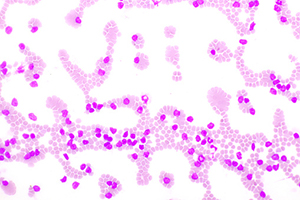A new prognostic tool may help to predict time to first treatment for patients with early-stage, asymptomatic chronic lymphocytic leukemia (CLL). Researchers described what they hope will become a point-of-care resource to help improve clinical decision-making in a study published by Rossi et al in the journal Blood.

Photo credit: Getty
In addition to offering patients a better sense of how they might need to adjust work, travel, and other activities to plan for cancer treatment, the prognostic tool can help doctors determine how frequently to monitor each patient. Most existing prognostic tools for CLL focus on assessing a patient’s chance of survival once the disease has progressed to the point that treatment is necessary. The new tool, called IPS-E, is the first validated prognostic score specifically tailored to forecast the need for treatment.
“While some patients display a milder disease never requiring therapy, others present active disease shortly after diagnosis and require intervention,” said lead study author Davide Rossi, MD, of the Institute of Oncology Research in Bellinzona, Switzerland, in a statement. “The IPS-E is a simple and a robust prognostic tool based on routine clinical and laboratory variables. The simplicity of IPS-E should facilitate its translation to the clinic.”
Methods
This research drew data from 4,933 patients with asymptomatic early-stage CLL who had participated in 11 international cohort studies. Starting with a training cohort of 333 patients, researchers found that three factors consistently and independently correlated with a shorter time to first treatment: unmutated immunoglobulin heavy chain variable region (IGHV) genes, high absolute lymphocyte counts, and palpable lymph nodes.
They used this information to develop a prognostic score with each factor counting as one point. Patients with zero factors are considered to have a low risk of needing treatment within 5 years of their diagnosis; patients with one factor are considered to face an intermediate risk; and patients with two or three factors are considered high-risk.
Scoring Validity
KEY POINTS
- Three factors consistently and independently correlated with a shorter time to first treatment: unmutated IGHV genes, high absolute lymphocyte counts, and palpable lymph nodes.
- Scores correlated closely with actual outcomes; of those in the low-risk category, 8.4% required treatment within 5 years compared to 28.4% in the intermediate-risk group and 61.2% in the high-risk group.
Validating the scoring system using data from 10 other cohorts, the researchers found that about 30% of patients were categorized as low-risk, 35% were intermediate-risk, and 35% were high-risk. The scores correlated closely with actual outcomes; of those in the low-risk category, 8.4% required treatment within 5 years compared to 28.4% in the intermediate-risk group and 61.2% in the high-risk group.
An additional benefit to the methods is that the three tests required to establish a patient’s prognostic score are widely available and used in patients with CLL: lymphocyte counts and lymph node status are already assessed as part of routine CLL diagnosis; IGHV status determination is typically performed when a patient is preparing to start treatment. Performing the IGHV test at the time of diagnosis may allow doctors and patients to benefit from the prognostic tool and the test would not need to be repeated later if the patient begins treatment.
“The IPS-E can be regarded as a building block to which newly discovered independent outcome predictors for patients with early-stage CLL could be added,” said Dr. Rossi. “A prospective study would help to further assess and eventually strengthen this prognostic tool.”
Disclosure: For full disclosures of the study authors, visit ashpublications.org.

